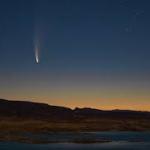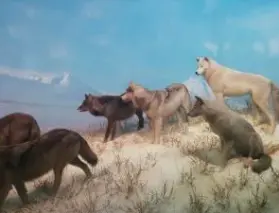 If you’ve ever visited the Grand Canyon, while gazing over its depths, perhaps you wondered about the time required for that little river to carve that vast chasm. As much as any place I’ve ever been, the Grand Canyon confronts you with the vastness of time.
If you’ve ever visited the Grand Canyon, while gazing over its depths, perhaps you wondered about the time required for that little river to carve that vast chasm. As much as any place I’ve ever been, the Grand Canyon confronts you with the vastness of time.
According to geologists, erosion of the canyon started about 6 million years ago, which by human standards is a very long time. But it’s a rather short time compared to how long it took for the 40 major sedimentary rock layers of the canyon to be deposited. The lower layers of these Grand Canyon sedimentary rocks formed, according to geologists, about 1.2 billion years ago, with an underlying layer of igneous rock even older. The topmost layers were deposited roughly 270 million years ago.
It’s hard to equate such a great thickness of stone and such a deep and broad canyon with numbers, but I find the following exercise helps. Consider a millimeter, which is a rather small measure of distance. If 1 mm of sediment were deposited each year, there would be one meter after a thousand years and a kilometer in a thousand thousand, or one million, years. The entire thickness of the Grand Canyon sedimentary stones is about 1.5 kilometers, so at a rate of 1 mm a year, it would take about 1.5 million years to deposit. Or, if we took the same amount as the rate of erosion into the canyon, it would take about 1.5 million years to carve out, which for us is a long time. In the vastness of geological time, however, 1.5 million years is not particularly long.
I was born in the little Minnesota town of Morton. Though its population is barely 400, I could always depend on geologists knowing about Morton. At the time I lived there, the Morton gneiss quarried nearby was considered the oldest exposed rock on earth. It was dated as being roughly 3.6 billion years old. When polished, it is a beautiful stone, and is quite commonly used as a facing stone in the upper Midwest, and I’ve seen it in buildings as far away as New York. In recent decades, other rocks have been found dating back to closer to 4 billion years, so Morton has lost its age distinction. Compared to the oldest rocks, the Grand Canyon is but a babe. (As a side note, my old town’s motto is “Morton, don’t take it for granite, it’s really gneiss,” which I think is one of the better town mottoes I’ve come across.)
It is estimated that the earth formed about 4.5-4.6 billion years ago, so the earth as a whole had been around for a billion years before the Morton gneiss came into existence. If the length of geological time is nearly incomprehensible, it is only about a third of the length of time that cosmologists estimate for the universe as a whole, which is about 14 billion years. Considered in the light of cosmological or even geologic time, a human life is a mere scintilla. The astronomer Carl Sagan gave the following example of that brevity: if the age of the universe is considered as a single year, the earliest human civilizations appeared only about 25 seconds to midnight on December 31. Our individual lives, on that scale, would be like that of a champagne bubble in small glass poured to celebrate the New Year.
How very quaint the old Christian notion that there is but 4000 years between the time when God created Adam and the birth of Christ and another 2000 from Christ to current time. Contemplation of geological time is a great antidote for the comfortable parochialism of the creationist, but it can leave one feeling rather unmoored. Or, to use a psychological term, it can leave us with cognitive dissonance. I know at a time in my life, I suffered such a cognitive dissonance. Here, though, I want to report on how I resolved that dissonance and came to a cognitive consonance, even a kind of joy in the vastness of time.
* * * * *
The vastness of time has often been presented as having nothing to do with us, of being alien to us. Such accounts, like that of Sagan, even go out of the way to emphasize how small and inconsequential we are against that vastness. But in fact, the vastness of time has everything to do with us. Quite simply, it was required for us to be here at all. It is part of what we are.
We are the products of biological evolution, and such evolution is slow. The first appearance of something that scientists can confidently call living organisms was about 3.7 billion years ago, or roughly the same time as the Morton gneiss came into existence. For some not well understood reason, these early forms of life stayed simple for a rather long time. Then, about a billion years ago, life started a process of complexifying that has gone on ever since. The relevant point is simply that it took virtually the whole of geologic history for life to appear and to evolve into something as complex as a human. Despite the fantasies of creationism, a slow process of evolution is the only way that a universe can create complex life.
But for the first living things to exist and begin the process of evolution, there had to be a place hospitable for such life, a planet in a solar system, and there had to be a chemistry complex enough to provide a wide variety of elements as the building blocks of life. The chemistry of the early universe, astronomers tell us, was nearly all hydrogen, thus too simple to generate anything very interesting. But thanks to the phenomenon so elegantly summarized in Einstein’s little equation, E=MC2, more complex elements, from helium to iron, will form in the center of stars, as hydrogen atoms fuse into more complex molecules, giving off tremendous amounts of energy in the process.
For the complex chemistry we find on earth to come into existence, an earlier generation of stars was required. At least one of these stars was of sufficient size that at the end of its life, it exploded in a supernovae, creating elements heavier than iron and flinging its whole chemical mélange into space as a great nebulae. It is out of that cosmic debris that the planets, and the chemicals that comprise our body, were formed.
So, to sum up, a great age of time was required for the physics of the universe to form galaxies and stars, another for these stars to burn up and expire; another for a new solar system to form from them; another for the earth to form and settle down; another for life to first appear and the process of biological evolution to kick into gear; and another for the first mammals and eventually the primates and then for humans to appear. In sum, a vastness of time is required for us to be here, nothing less would do.
It is not my intention to suggest that we are the reason that the natural order, with its vastness of time, exists as it does, nor that all this cosmic self-organization and evolution has taken place for our benefit. There is absolutely no evidence for that (though nothing that prohibits it, either). I am only saying that the natural order has to be largely as it is, with its vastness of time and space, or we simply wouldn’t be here. The questions of “why it is that way” and “why we are here” is beyond our knowing, it is part of the great mystery.
* * * * *
Far from feeling alienated by those great ages, we should recognize that we belong to them. Every particle of matter in our being arose around the time of the Big Bang, and took the form of a particular element more than five billion years ago. Every bit of information carried in our genetic code is the result of the four billion years of biological evolution. And virtually every worthwhile idea that enters our little heads, such as the one I’m trying to present here, came about from the slow process of cultural evolution that began with the earliest humans, and which continues with great rapidity at present.
From the naturalistic point of view, humans are completely a part of the natural order. Yet, even among people who hold the naturalistic view, there is a tendency to see ourselves as outside the natural order, to see at least some of our creations and activities as unnatural. This is probably the result of the deep seated dualism in Western culture, which we inherit from both the Judeo-Christian and Greek roots of our culture.
That we should feel alienated by the vastness of time and space is like the notion that, “the more we understand the universe, the more we find it meaningless,” as Steven Weinberg put it. Weinberg is a great scientist, but what he states here is in no way a scientific idea, it is a personal interpretation. I say that the more we truly understand Nature and understand ourselves, the more meaningful and downright wonderful we find It. Afterall, Nature gives rise to beings like us that seek and find value and meaning, and further, all that is valued and found meaningful by such creatures, is a part of Nature. It simply follows that Nature, through spawning creatures like us, also spawned value and meaning.
Nature is our ultimate parent, and though it does not care for us like some imaginary god might, it has given us everything we need to flourish for our brief moment in time. Being the small, fragile, creatures that we are, it is all too human to wish that Nature were like a caring parent. But it isn’t. Nature is not a person – but each of us is. It is for people to care about people, to show kindness and compassion for others. And it is for people to develop the abilities that Nature has given, possibly even to gain a more enlightened perspective on how to live in accord with the way of Nature. For when we are truly in accord with Nature, we become part of its vastness – and something of that vastness can be experienced in each moment when we are fully present to it.
Note: (1) I use the term “Nature,” with the capitalization, to denote the entire cosmological process of the existing world. Included in the term “Nature” is the entire phenomenal world as studies by scientists, but also the mystery of ultimate origins, that area of speculation that has often occupied philosophers. As such, the idea conveyed by the term “Nature” is not so different from the idea carried by the notion of a non-anthropological god, something capable of generating a self-organizing universe, but lacking intention, thought or emotion. I use “nature” uncapitalized, when referring to the more common usage of nature vs. human.
Subscribe to The Spiritual Naturalist Society
Learn about Membership in the Spiritual Naturalist Society
The Spiritual Naturalist Society works to spread awareness of spiritual naturalism as a way of life, develop its thought and practice, and help bring together like-minded practitioners in fellowship.
SNS strives to include diverse voices within the spectrum of naturalistic spirituality. Authors will vary in their opinions, terms, and outlook. The views of no single author therefore necessarily reflect those of all Spiritual Naturalists or of SNS.













